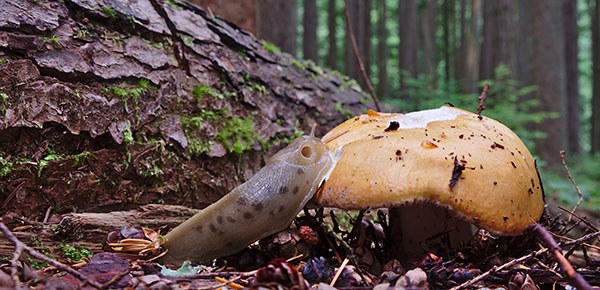
The Pacific Northwest is home to many unique and beautiful animals, but there is one strange, slimy creature that is often overlooked: The Pacific banana slug. Oft-forgotten until they’re underfoot, banana slugs are critically important members of the forest community from southeast Alaska to central California, and they play a big role in our ecosystems each autumn.
Slug snapshot
For those of you who have yet to encounter one, Pacific banana slugs are the second-largest slug in the world, growing up to 9 inches long. They are also one of the slowest species on the planet, with an average speed of 6.5 inches per minute. A vibrant yellow or brownish-green color, they can resemble an overripe banana with their black spots.
Banana slugs rely on moisture to stay alive, so during warm or dry periods they produce extra slime, bury themselves in leaves, and enter a dormant “summer sleep” known as aestivation. But with the return of rainy weather, these creatures are once again moving safely across the forest floor.
By contracting and relaxing a muscular “foot,” slugs generate a wave that propels them smoothly forward. Two sets of tentacles allow them to sense their environment. The upper pair of tentacles has tiny black “eyes” that detect light and movement. Their eyestems can stretch up and move in all directions, enabling slugs to peer over woodland obstacles. Often called “feeler stalks,” the shorter pair of tentacles below is for feeling and smelling. Luckily, if a tentacle gets injured or bitten off, it can grow back!
Role in the ecosystem
Pacific banana slugs are the forest floor clean-up crew. By chewing on dead organic matter, including fallen leaves, moss, and animal droppings, these native detritivores recycle nutrients. Slug excretions not only provide a nitrogen-rich fertilizer for plant growth, but also disperse spores and seeds required for forest regeneration. Banana slugs help to break down fallen leaves each autumn, making way for new growth in the understory in spring.
Banana slugs devour just about everything they find with their radula (a tongue of microscopic teeth) – with one important exception. No matter how hungry they are, Pacific banana slugs won’t eat redwood tree seedlings. This adaptation has a clear evolutionary advantage; by avoiding these distasteful seeds, banana slugs protect the very trees that form the damp habitat they need to survive.
What’s with all the slime?
Slime is the slug’s superpower. In addition to locomotion and hydration, slime is essential for defense. When threatened, banana slugs produce extra slime to ward off predators, or at the very least, make it an unpleasant dining experience. The slug’s mucus also contains an anesthetic that causes the predator’s mouth to go numb. While most animals pass on this nasty mouthful of slime, clever raccoons roll slugs in dirt to coat them before eating. Chocolate-covered banana, anyone?
Human uses for slime
What if I told you that some pretty cool inventions were inspired by slug slime? By studying the versatile properties of this goo, scientists have created new surgical glues for medical procedures. Another group of engineers have built slug-inspired greenhouses that use slime insulation to store and release water, much like the banana slug’s mucus-coated body.
How to see banana slugs for yourself
In the wettest parts of Washington, such as the Hoh or Quinault Rainforest, keep your eyes peeled for mushrooms with dime-sized nibbles and glistening trails of clear slime on decaying plants or spider webs. You’ll likely spot a slug or two - just be careful to watch your step.
These slimy forest friends can sometimes be perilous! Read the story of a member who slipped on a slug and broke her hip on a backpacking trip: mountaineers.org/blog/safety-stories-beware-of-slugs
This article originally appeared in our Fall 2021 issue of Mountaineer Magazine. To view the original article in magazine form and read more stories from our publication, visit our magazine archive.
 Issy Steckel
Issy Steckel